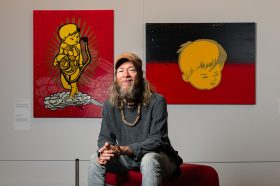Polly Borland has made a career out of photographing others. Over the last several decades, the Melbourne-born, Los Angeles-based artist has photographed the likes of Susan Sontag, Nick Cave, Cate Blanchett and Queen Elizabeth II. And now, for the first time in her professional life, Borland is turning the camera on herself.
Nudie and Blobs is the title of Borland’s latest Australian exhibition, currently on show at STATION Melbourne. Featuring five large-scale photographs (all of which were shot on an iPhone) and two resin sculptures, this exhibition is a radical study of the human body.
Upon entering the space, one is immediately drawn to Borland’s Nudie works, a collection of five photographs that display a female body – specifically Borland’s – in close and intimate detail. In these works, she presents us with a naked, obscured and fragmented version of herself. She looms over us with dimpled folds and draping breasts, bringing into view a cropped body that almost appears to trickle out of the picture frame.
These photographs depict Borland’s own body; however, they are not portraits in the traditional sense. In Nudie (4) (2021), for example, we see a body that has been twisted and contorted almost to the point of complete abstraction. Here, Borland asks us to think about what we are looking at and, in doing so, challenges the representational nature of photography itself.
Borland’s decision to photograph her own naked body is significant for two reasons. The first being that it provides us with an opportunity to reconsider representations of women in art, and the second being that it allows for a total removal of the female body from the male gaze.
In a move reminiscent of Jenny Saville’s feminist nudes from the 1990s, Borland defies the traditional and idealised view of the female nude by presenting to us instead these large-scale, abject versions in which Borland claims agency as both the artist and the artist’s model. In these photographs, she shows us her body as she sees it, complete with its wrinkles, veins and loose skin. It’s not supposed to be pretty, but it is supposed to be subversive. By crafting these uncompromising images of her ageing body, Borland counters traditional conceptualisations of female beauty and radically challenges one of the most established conventions of Western art.
In the corner of the gallery stand two sculptures titled Blobs 1 (2023) and Blobs 2 (2023). Crafted out of resin, these sculptures have a soft and organic quality to them. And, despite being abstract in nature, they still possess a human quality that is so beautifully emblematic of Borland’s practice at large.
Although Blobs 1 and Blobs 2 are the only two sculptural works in the exhibition, it feels as if Borland has approached all her works in a similar way; that is, from the perspective of a sculptor. In the Nudie photographs, we see Borland confront the materiality of her own body. She kneads and twists and folds her flesh into different shapes, rendering herself both malleable and elastic. Here, Borland injects a new layer of dimensionality into her photographs and, in doing so, pushes the boundaries of the medium itself.
Read: Exhibition review: Ctrl + Alt + Delete: Reclaim
Borland’s works constantly oscillate between being abject and beautiful, ambiguous and precise, grotesque and alluring. By teetering along these dichotomous lines and working from that space of in-betweenness, Borland invites us to find beauty in the ambiguity of it all. And believe me, once you find it, it’s impossible to look away.
Nudie and Blobs continues at STATION Melbourne, until 25 February 2023; free.





